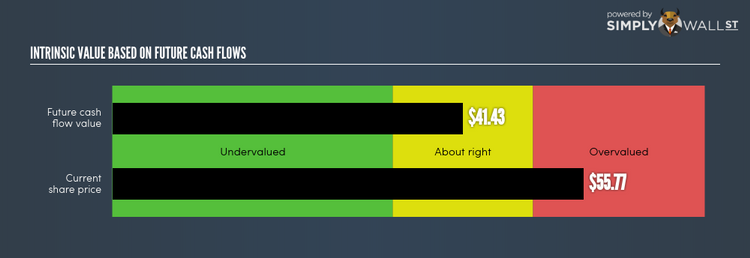The Bank of New York Mellon Corporation (NYSE:BK) Investors Are Paying Above The Intrinsic Value

One of the most difficult industry to value is capital markets, given that they adhere to different rules compared to other companies. Asset managers, for example, must hold certain levels of capital in order to maintain a safe cash cushion. Looking at factors such as book values, as well as the return and cost of equity, may be practical for determining BK’s value. Below I’ll determine how to value BK in a reasonably accurate and easy way. See our latest analysis for Bank of New York Mellon
Why Excess Return Model?
There are two facets to consider: regulation and type of assets. Financial firms operating in United States face strict financial regulation. In addition, capital markets tend to not hold substantial amounts of tangible assets on their balance sheet. So the Excess Returns model is suitable for determining the intrinsic value of BK rather than the traditional discounted cash flow model, which places emphasis on factors such as depreciation and capex.
Deriving BK’s True Value
The main assumption for Excess Returns is, the value of the company is how much money it can generate from its current level of equity capital, in excess of the cost of that capital. The returns above the cost of equity is known as excess returns:
Excess Return Per Share = (Stable Return On Equity – Cost Of Equity) (Book Value Of Equity Per Share)
= (11.24% – 11.11%) * $40.8 = $0.05
We use this value to calculate the terminal value of the company, which is how much we expect the company to continue to earn every year, forever. This is a common component of discounted cash flow models:
Terminal Value Per Share = Excess Return Per Share / (Cost of Equity – Expected Growth Rate)
= $0.05 / (11.11% – 2.95%) = $0.64
These factors are combined to calculate the true value of BK’s stock:
Value Per Share = Book Value of Equity Per Share + Terminal Value Per Share
= $40.8 + $0.64 = $41.43
Relative to today’s price of $55.77, BK is currently priced higher than its intrinsic value. Therefore, there’s no benefit to buying BK today. Pricing is only one aspect when you’re looking at whether to buy or sell BK. Fundamental factors are key to determining if BK fits with the rest of your portfolio holdings.
Next Steps:
For capital markets, there are three key aspects you should look at:
Financial health: Does it have a healthy balance sheet? Take a look at our free bank analysis with six simple checks on things like leverage and risk.
Future earnings: What does the market think of BK going forward? Our analyst growth expectation chart helps visualize BK’s growth potential over the upcoming years.
Dividends: Most people buy financial stocks for their healthy and stable dividends. Check out whether BK is a dividend Rockstar with our historical and future dividend analysis.
For more details and sources, take a look at our full calculation on BK here.
To help readers see pass the short term volatility of the financial market, we aim to bring you a long-term focused research analysis purely driven by fundamental data. Note that our analysis does not factor in the latest price sensitive company announcements.
The author is an independent contributor and at the time of publication had no position in the stocks mentioned.

 Yahoo Finance
Yahoo Finance 
